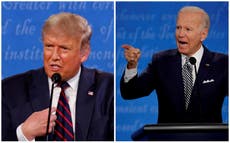Thousands of polls closed across US ahead of 2020 elections
Dramatic loss of voting precincts disproportionately impacts voters of colour, reports find
Your support helps us to tell the story
From reproductive rights to climate change to Big Tech, The Independent is on the ground when the story is developing. Whether it's investigating the financials of Elon Musk's pro-Trump PAC or producing our latest documentary, 'The A Word', which shines a light on the American women fighting for reproductive rights, we know how important it is to parse out the facts from the messaging.
At such a critical moment in US history, we need reporters on the ground. Your donation allows us to keep sending journalists to speak to both sides of the story.
The Independent is trusted by Americans across the entire political spectrum. And unlike many other quality news outlets, we choose not to lock Americans out of our reporting and analysis with paywalls. We believe quality journalism should be available to everyone, paid for by those who can afford it.
Your support makes all the difference.Hours-long lines have been reported across the US over the last two weeks of early voting ahead of Election Day in the 2020 elections, with an unprecedented turnout that has surpassed the early vote total from 2016’s presidential election and – in some states – all the votes reported from that year.
While the lines and number of ballots cast show significant voter enthusiasm, they underscore persistent voting access issues that disproportionately impact Black voters and voters of colour.
As of 30 October, more than 86 million Americans have cast ballots ahead of Election Day on 3 November. That total includes more than 30 million people who voted in person and 55.5 million mail-in ballots returned to election officials, according to the US Elections Project, which has been tracking early vote totals.
It’s unclear whether that turnout glimpses another unprecedented rush to the polls on Election Day, or represents voters who voted early when they otherwise would have done so in-person on 3 November to avoid crowding precincts during the coronavirus pandemic.
Voting advocacy groups have signalled that extreme wait times and reports of struggling polls are suppressing votes, by turning would-be voters away from the polls and diminishing overall turnout.
Nearly 21,000 Election Day polling locations have closed ahead of 2020 presidential elections, down from previous presidential election cycles in 2016 and 2012, according to an analysis from VICE News, which found widespread closures as districts endure coronavirus-related closures, cost-cutting measures and legislated voter suppression.
The report found that of 45 states that did not use mail-in voting exclusively before 2020 elections, 40 decreased their Election Day polling locations from 2016.
Of those states, 35 are not sending mail-in ballots to all eligible voters, and 19 require applications for mail-in ballots. Five states that rejected universal mail-in voting for most residents cut the number of polling sites.
The changes represent a 20 per cent cut of polling locations nationwide within just four years.
Poll closures and long wait times disproportionately impact Black and Latino voters compared to white voters, several analyses have found.
“In the past, long wait times were disruptive and disenfranchising. In the middle of a pandemic, they could also be deadly,” according to a 2020 report from The Brennan Center for Justice at the New York University School of Law.
In its 2020 report, the Brennan Center found that more than 6 per cent of Latino voters and 7 per cent of Black voters reported waiting 30 minutes or longer to vote, surpassing the acceptable threshold for wait times set by the Presidential Commission on Election Administration.
That figure falls to 4.1 per cent among white voters.
More generally, Latino voters waited on average 46 per cent longer than white voters, and Black voters waited on average 45 per cent longer than white voters, according to the report.
Counties that became less white over the past decade also had fewer election resources than whiter counterparts – the average county where the white population grew had 63 voters per poll worker and roughly 390 voters per polling place, the Brennan Center found.
But the average county that became less white had 80 voters per worker and 550 voters per polling place.
The landmark 1965 Voting Rights Act also established that states with a history of voter discrimination must have federal approval before changing election rules – but those rules were tossed out in 2013 by a split US Supreme Court. Fifteen states had closed more than 1,600 polls between 2012 and 2018.
A report from the Leadership Conference on Civil & Human Rights said that decision “catalysed a systemic examination of poll closures and other seemingly innocuous changes that could have negatively impacted voters of colour."
Subscribe to Independent Premium to bookmark this article
Want to bookmark your favourite articles and stories to read or reference later? Start your Independent Premium subscription today.




Join our commenting forum
Join thought-provoking conversations, follow other Independent readers and see their replies
Comments